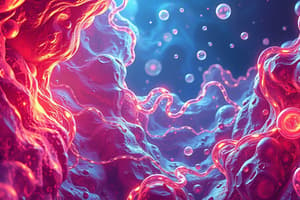Podcast
Questions and Answers
What effect does increasing the molecular weight of a linear polymer typically have on its crystallinity?
What effect does increasing the molecular weight of a linear polymer typically have on its crystallinity?
- Decreases crystallinity, as longer chains entangle more easily, hindering crystal formation.
- Leads to a decrease in crystallinity, but only in polymers with strong intermolecular forces.
- Has minimal effect on crystallinity, as it primarily impacts the polymer's viscosity.
- Increases crystallinity, due to increased intermolecular interactions and reduced mobility. (correct)
Which of these is NOT a common method for enhancing the crystallinity of a polymer?
Which of these is NOT a common method for enhancing the crystallinity of a polymer?
- Utilizing nucleating agents like metal salts.
- Adding plasticizers to increase chain mobility. (correct)
- Annealing at temperatures below the melting point.
- Stretching the polymer to align molecular chains.
Based on the provided information, what is the primary characteristic that distinguishes the 'Fringed Micelle Model' from the 'Folded Chain Lamella Model' of polymer structure?
Based on the provided information, what is the primary characteristic that distinguishes the 'Fringed Micelle Model' from the 'Folded Chain Lamella Model' of polymer structure?
- The presence of amorphous regions in the Fringed Micelle Model and their absence in the Folded Chain Lamella Model.
- The type of intermolecular forces present, with the Fringed Micelle Model exhibiting weaker forces.
- The degree of crystallinity, with the Fringed Micelle Model possessing significantly lower crystallinity. (correct)
- The presence of spherulites in the Fringed Micelle Model, as opposed to the absence in the Folded Chain Lamella Model.
What is the most important factor influencing the rate of crystal growth in a polymeric material, as described by the Avrami equation?
What is the most important factor influencing the rate of crystal growth in a polymeric material, as described by the Avrami equation?
Identify the technique that directly measures the heat required for melting or crystallization, thus providing information about the degree of crystallinity in a polymeric material.
Identify the technique that directly measures the heat required for melting or crystallization, thus providing information about the degree of crystallinity in a polymeric material.
Which of the following describes the primary behavior of a polymer in its glassy state?
Which of the following describes the primary behavior of a polymer in its glassy state?
Consider a polymer with a high degree of crystallinity. What would logically be the primary reason for its structural stability and toughness?
Consider a polymer with a high degree of crystallinity. What would logically be the primary reason for its structural stability and toughness?
What is the main difference between Shish-Kebab and spherulite structures in semicrystalline polymers?
What is the main difference between Shish-Kebab and spherulite structures in semicrystalline polymers?
What does the term 'tacticity' refer to in polymer science?
What does the term 'tacticity' refer to in polymer science?
Which molecular weight measure is determined by using techniques like the Mark-Houwink equation?
Which molecular weight measure is determined by using techniques like the Mark-Houwink equation?
Under what condition does crystallization occur in polymers?
Under what condition does crystallization occur in polymers?
Which of the following configurations is most likely to favor crystal formation in polymers?
Which of the following configurations is most likely to favor crystal formation in polymers?
What parameter indicates the distance between entanglements in polymers?
What parameter indicates the distance between entanglements in polymers?
What is a characteristic of branched polymers compared to linear polymers?
What is a characteristic of branched polymers compared to linear polymers?
Which factor does NOT significantly affect the crystallization process of polymers?
Which factor does NOT significantly affect the crystallization process of polymers?
What is the typical range of degrees of crystallinity for polymers?
What is the typical range of degrees of crystallinity for polymers?
Which process is associated with the formation of cross-linked polymers?
Which process is associated with the formation of cross-linked polymers?
Which type of copolymer features monomers distributed randomly throughout the chain?
Which type of copolymer features monomers distributed randomly throughout the chain?
Which property is most directly influenced by the molecular weight of a polymer?
Which property is most directly influenced by the molecular weight of a polymer?
What distinguishes thermosets from thermoplastics regarding their recycling capability?
What distinguishes thermosets from thermoplastics regarding their recycling capability?
Which of the following best describes the structure of block copolymers?
Which of the following best describes the structure of block copolymers?
What are some major issues associated with polymers in terms of environmental impact?
What are some major issues associated with polymers in terms of environmental impact?
What type of interactions primarily influence the properties of linear polymers?
What type of interactions primarily influence the properties of linear polymers?
What is the primary role of additives in polymers?
What is the primary role of additives in polymers?
Which type of wear occurs when small particles detach due to surface adhesion?
Which type of wear occurs when small particles detach due to surface adhesion?
What is the primary factor influencing deformation in rough surfaces at high speeds?
What is the primary factor influencing deformation in rough surfaces at high speeds?
How does temperature influence polymers during deformation?
How does temperature influence polymers during deformation?
What is the Heat Deflection Temperature (HDT) primarily used to measure?
What is the Heat Deflection Temperature (HDT) primarily used to measure?
What effect do plasticizers have on a polymer's Heat Deflection Temperature (HDT)?
What effect do plasticizers have on a polymer's Heat Deflection Temperature (HDT)?
Which temperature marks the transition from solid to liquid in crystalline polymers?
Which temperature marks the transition from solid to liquid in crystalline polymers?
What distinguishes the Vicat Softening Temperature (VST) from Heat Deflection Temperature (HDT)?
What distinguishes the Vicat Softening Temperature (VST) from Heat Deflection Temperature (HDT)?
What is the primary driving factor for thermal expansion in polymers?
What is the primary driving factor for thermal expansion in polymers?
What characterizes the behavior of Bingham fluids?
What characterizes the behavior of Bingham fluids?
In the context of rheology, what is the main difference between true and apparent rheopexy?
In the context of rheology, what is the main difference between true and apparent rheopexy?
Which aspect of the Kaye Effect is primarily responsible for its behavior?
Which aspect of the Kaye Effect is primarily responsible for its behavior?
What is the relationship between zero-shear viscosity and molecular weight in polymers?
What is the relationship between zero-shear viscosity and molecular weight in polymers?
What phenomenon is described by the Weissenberg Effect?
What phenomenon is described by the Weissenberg Effect?
How does shear thinning behavior manifest in materials?
How does shear thinning behavior manifest in materials?
What effect occurs when polymers expand after exiting a narrow opening?
What effect occurs when polymers expand after exiting a narrow opening?
In the Bingham model, what does the variable $ au_0$ represent?
In the Bingham model, what does the variable $ au_0$ represent?
Which factor is least likely to increase the glass transition temperature (Tg) of a polymer?
Which factor is least likely to increase the glass transition temperature (Tg) of a polymer?
What happens to the glass transition temperature (Tg) when flexible side chains are incorporated into a polymer?
What happens to the glass transition temperature (Tg) when flexible side chains are incorporated into a polymer?
Which description accurately defines miscible polymer blends?
Which description accurately defines miscible polymer blends?
How do cross-linking interactions influence the glass transition temperature (Tg) of a polymer?
How do cross-linking interactions influence the glass transition temperature (Tg) of a polymer?
Which of the following is a characteristic of β transition in polymers?
Which of the following is a characteristic of β transition in polymers?
What is the primary purpose of using plasticizers in polymer blends?
What is the primary purpose of using plasticizers in polymer blends?
How does the presence of strong intermolecular forces affect the Tg of a polymer?
How does the presence of strong intermolecular forces affect the Tg of a polymer?
Which mechanical property describes a polymer's resistance to bending forces?
Which mechanical property describes a polymer's resistance to bending forces?
Flashcards
Configuration in Polymers
Configuration in Polymers
The arrangement of atoms in a polymer that requires breaking covalent bonds.
Tacticity
Tacticity
The stereoregularity of polymer chains, classified as atactic, isotactic, or syndiotactic.
Molecular Weight (MW)
Molecular Weight (MW)
A measure of polymer properties; includes Mn, Mw, Mz, and Mv.
Chain Entanglement
Chain Entanglement
Signup and view all the flashcards
Glass Transition Temperature (Tg)
Glass Transition Temperature (Tg)
Signup and view all the flashcards
Crystallization Requirements
Crystallization Requirements
Signup and view all the flashcards
Crystallinity in Polymers
Crystallinity in Polymers
Signup and view all the flashcards
Factors Affecting Crystallinity
Factors Affecting Crystallinity
Signup and view all the flashcards
Friction
Friction
Signup and view all the flashcards
Adhesive Wear
Adhesive Wear
Signup and view all the flashcards
Elastic Deformation
Elastic Deformation
Signup and view all the flashcards
Plastic Deformation
Plastic Deformation
Signup and view all the flashcards
Melting Temperature (Tm)
Melting Temperature (Tm)
Signup and view all the flashcards
Heat Deflection Temperature (HDT)
Heat Deflection Temperature (HDT)
Signup and view all the flashcards
Vicat Softening Temperature (VST)
Vicat Softening Temperature (VST)
Signup and view all the flashcards
Thermal Expansion
Thermal Expansion
Signup and view all the flashcards
Polymers
Polymers
Signup and view all the flashcards
Polymerization
Polymerization
Signup and view all the flashcards
Step Growth
Step Growth
Signup and view all the flashcards
Chain Growth
Chain Growth
Signup and view all the flashcards
Thermoplastics
Thermoplastics
Signup and view all the flashcards
Linear Polymer Crystallinity
Linear Polymer Crystallinity
Signup and view all the flashcards
Thermosets
Thermosets
Signup and view all the flashcards
Copolymers
Copolymers
Signup and view all the flashcards
Fringed Micelle Model
Fringed Micelle Model
Signup and view all the flashcards
Folded Chain Lamella Model
Folded Chain Lamella Model
Signup and view all the flashcards
Block Copolymers
Block Copolymers
Signup and view all the flashcards
Spherulites
Spherulites
Signup and view all the flashcards
Shish-kebab Structure
Shish-kebab Structure
Signup and view all the flashcards
Controlled Cooling
Controlled Cooling
Signup and view all the flashcards
Differential Scanning Calorimetry (DSC)
Differential Scanning Calorimetry (DSC)
Signup and view all the flashcards
Higher Mw and Tg
Higher Mw and Tg
Signup and view all the flashcards
Syndiotactic Polymers
Syndiotactic Polymers
Signup and view all the flashcards
Side Chain Effect on Tg
Side Chain Effect on Tg
Signup and view all the flashcards
Intermolecular Forces Impact
Intermolecular Forces Impact
Signup and view all the flashcards
Cross-Linking Effect
Cross-Linking Effect
Signup and view all the flashcards
Types of Polymer Blends
Types of Polymer Blends
Signup and view all the flashcards
Types of Deforming Forces
Types of Deforming Forces
Signup and view all the flashcards
Rheopexy
Rheopexy
Signup and view all the flashcards
Bingham Fluids
Bingham Fluids
Signup and view all the flashcards
Yield Stress
Yield Stress
Signup and view all the flashcards
Shear Thinning
Shear Thinning
Signup and view all the flashcards
Shear Thickening
Shear Thickening
Signup and view all the flashcards
Kaye Effect
Kaye Effect
Signup and view all the flashcards
Weissenberg Effect
Weissenberg Effect
Signup and view all the flashcards
Zero-Shear Viscosity
Zero-Shear Viscosity
Signup and view all the flashcards
Study Notes
LECTURE 1
- Introduction to polymers
LECTURE 2
- Polymer Basics
- Polymers are formed by the polymerization of monomers.
- Step-growth polymerization: Every monomer can start polymerization thanks to an initiator.
- Chain-growth polymerization: Few monomers can initiate growth, but it happens extremely quickly.
- Classification: Synthetic or semi-synthetic, usually used in plastics.
- Additives: Commonly incorporated into polymers.
- Applications: Electronics, safety equipment, and medical devices.
- Issues: Production (plants/oil), usage (microplastics), and waste management (recycling/incineration/landfill).
- Polymer Morphology
- Definition: The spatial arrangement of polymer chains (crystalline and amorphous regions); affects mechanical, thermal, and optical properties.
- Types:
- Linear Polymers: Flexible, interact via van der Waals and hydrogen bonding.
- Branched Polymers: Side chains off the main chain; lower density due to less packing.
- Cross-linked Polymers: Covalent bonds between chains (e.g., vulcanization of elastomers).
- Networked Polymers: Formed via physical or chemical interactions.
- Thermoplastics and Thermosets
- Thermoplastics: Can be melted and reshaped; easy to recycle as they don't lose integrity when melted
- Thermosets: Decompose before melting (e.g., cured or cross-linked polymers).
- Copolymers
- Definition: Polymers composed of two or more different monomers.
- Types:
- Random Copolymers: Monomers are randomly distributed along the chain. The sequence does not follow any particular order, leading to varied properties.
LECTURE 3
- Crystallinity in Polymers
- Discovery and Basics: Polymers cannot be 100% crystalline due to molecular imperfections.
- Typical degree: 30% to 80%, depending on the polymer type.
- Requirements for Crystallization:
- Regular configurations: (isotactic or syndiotactic) promote crystallization while atactic polymers struggle.
- Symmetrical binding: Head-to-tail configurations favor crystal formation over head-to-head.
- Short & sparse side chains: Support crystallization; bulky/irregular chains impede it.
- Intermediate chain flexibility is necessary; very rigid or highly flexible polymers cannot crystallize effectively.
- Factors Affecting Crystallinity:
- Regular copolymer structures increase crystallization chances.
- Linear polymers have higher chances of crystallizing.
- Higher molecular weights generally increase crystallinity.
- Strong inter- and intra-molecular forces (e.g., hydrogen bonds) enhance crystallinity.
- Cooling rates, evaporation, and annealing conditions affect crystallinity.
LECTURE 4
- Glass Transition Temperature (Tg)
- Definition: The temperature range between glassy and rubbery states where chain segments gain coordinated motion.
- Glassy State: Hard, rigid, brittle; limited atomic motion.
- Rubbery State: Soft, flexible; long-range rotational motion of chain segments.
- Analysis Techniques
- GPC/SEC: Measures molecular weight distribution using hydrodynamic volume.
- Other Methods: Viscosimetry, ultracentrifugation, light scattering, and more.
LECTURE 5
- Mechanical Properties of Polymers
- Types of Deforming Forces: Tensile, Compressive, Shear, Bending, Impact, Creep, and Stress Relaxation.
- Thermal Effects: Heat deflection temperature, softening temperature and thermal expansion.
- Failure Mechanisms: Ductile and brittle failure, crazing.
- Common Failure Modes: Creep failure, fatigue failure, and impact failure.
- Improving Failure Resistance: Using fibers, crosslinking, and polymer blending.
- Mechanical Testing: Tensile, compressive, shear, flexural, and impact tests for characterizing mechanical behavior.
LECTURE 6
- Compressive Testing
- Definition: Measures material response under compression.
- Measured Properties: Compressive modulus, yield point, compressive strength
- Thermoplastics Behavior: Excessive deformation before failure, reported as stress at specific deformations (e.g., 1%, 2%, or 10%).
- Shear and Bending Properties
- Shear Testing: Measures material response to parallel forces.
- Shearing forces: Distort the object rather than pulling or compressing it.
- Measurement Techniques: Various instruments depending on fluid properties for measuring viscosity, elasticity, and flow behavior.
LECTURE 7
- Thermal Properties of Polymers
- Key Temperatures: Melting temperature (Tm), glass transition temperature (Tg), and crystallization temperature (Tc).
- Heat Deflection Temperature (HDT): The highest temperature at which a polymer can withstand a specific load without significant deformation.
- Test Procedure: Immerse sample in silicone oil bath, and increase temperature gradually while applying a load.
LECTURE 8
-
Introduction to Rheology
- Definition: The science of how liquids flow and solids deform
- Measurement Methods (Rheometry): Experimental methods to measure rheological properties (e.g., viscosity).
-
Viscosity:
- Definition: Resistance of a material to shearing forces
- Newton's Law: τ = η γ [shear stress = viscosity × shear rate]
- Factors Affecting Viscosity: Temperature (higher temp → lower viscosity), pressure, time, molecular weight, and additives (e.g., fillers).
LECTURE 9
- Bingham Model & Yield Stress: Material behaves as solid at low stress, flows as liquid above threshold (yield stress)
- Benefits of Bingham Flow: Prevents phase separation, reduce sedimentation and flocculation, enhance stability of emulsions and suspensions.
- Types of Non-Newtonian Flows: Shear thinning (pseudoplasticity), shear thickening (dilatancy), Bingham flow, Bingham pseudoplastic, Bingham dilatant.
LECTURE 10
- Rheological Measurement Methods: Description of techniques for measuring rheological properties of various materials (e.g., viscosity, elasticity, and flow behavior).
- Common Measurement Techniques: Descriptions of common laboratory techniques (e.g., Ostwald viscometer).
LECTURE 11
- Oscillating analysis measurement Techniques: Amplitude sweep and frequency sweep used to determine material behavior in different regions.
- Cox-Merz Rule: Steady-state shear viscosity at a given shear rate ≈ complex viscosity at the same frequency; valid for polymer melts, concentrated/semi-dilute solutions.
- Deborah Number (De): Determines material behavior as solid-like or liquid-like (De < 1: viscous response, De ~1: viscoelastic response, De>>1: elastic response).
Additional Topics (From other Sections)
- Tensile Testing and Stress-Strain Behavior: Procedure, output, and key terms to understand tensile testing of materials.
- Factors Affecting Polymer Modulus: Key factors like temperature and molecular weight affecting a polymer's modulus.
- Yielding and Plastic Deformation: Yield point, plastic deformation, necking, and descriptions of ductile/brittle behaviours.
- Fatigue Failure: Definition and description of crack growth due to cyclic loading.
- Crazing: Description of microcavities formed in glassy polymers under excessive tensile stress before yielding.
- Brittle Failure: Description of fracture with minimal deformation.
- Surface Properties: Hardness, friction, and wear resistance.
- Material Modification: Toughening polymers with rubber phases.
Studying That Suits You
Use AI to generate personalized quizzes and flashcards to suit your learning preferences.




